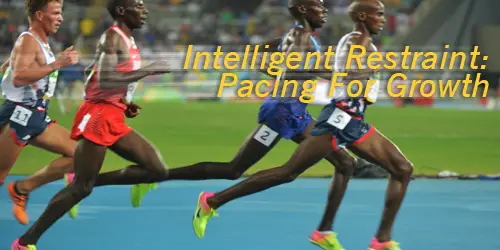 |
 |
03.15.17

Intelligent Restraint: Pacing for Growth
W Athletes know that the right pace in both training and racing is key to winning. It is a common belief that pushing ourselves or our organizations past our limits is the best strategy fro growth. But if you go too fast or push too hard you cannot only burn out but cause injuries and setbacks. At the same time, if you go too slow, you will get left in the dust. Find the right pace is key to successful growth and long-term success. Long-term success also requires that we execute our core business today while preparing ourselves for the future. In Pacing for Growth, Alison Eyring addresses this tension and how we can find the pace that avoids the wasted effort and the frustrating boom-splat cycles common to growth initiatives. The concept is called Intelligent Restraint. Intelligent Restraint is basically operating within the limits of the capacity and capabilities we have today and no further while we also build a base of the right capabilities for long term enduring growth. The three core principles of Intelligent Restraint are: Principle One: Capacity determines how far and fast you can go. Maximum capacity is the highest level of performance at which a system can perform without breaking down. When we understand the gaps between performance and capacity and how maximum capacity in the future will be different from today, we can create a program to build capabilities that increase capacity. Principle Two: The right capabilities increase capacity. The key is to be crystal clear what capabilities are most critical for growth in your business. What are the critical few capabilities your strategy requires you to execute fabulously well? Principle Three: The right pace wins the race. Growth leaders understand how and when to push faster and when to slow things down. In a race, we need to conserve some energy to maintain a fast pace and we need to perseverance to sustain this pace even when it become uncomfortable. Growth requires trade-offs like exploring new opportunities while exploiting existing assets. Eyring says there are three rules to keep in mind. Rule #1: Focus overrules vision. Vision is important and gets you going but focus is what gets you over the finish line. By learning to focus and then align people and pother resources to that focus, you can conserve time and energy that can be used to build new capabilities for growth. Making focused choices is Intelligent Restraint at work. Rule #2: Routines beat strengths. Strengths are useful but they can become a liability when overused. The right routines efficiently shape new ways of thinking and behaving that are need for growth. When we repeat the same thing over and over, we can perfect our technique, But when we repeat progressively challenging routines, we build endurance. Rule #3: Exert then Recover. To deliver results and build capacity for growth at the same time requires high levels of exertion that consumes personal and organizational energy that must be replenished. As a growth leader, you may need to intentionally slow things down. A sign that you’re growing at the wrong pace is that you lack the capacity or infrastructure to support what you trying to do. This results in chronic mistakes, poor customer service, and in some industries, safety violations and injuries. You know you are at the right pace when you can deliver the results intended by the growth initiative while at the same time having the space to give thought to and build for future growth. Eyring offers an online assessment to determine if your organization is setting the right pace on her Organization Solutions web site. 
Posted by Michael McKinney at 11:40 PM
|
BUILD YOUR KNOWLEDGE
 

How to Do Your Start-Up Right STRAIGHT TALK FOR START-UPS 
Grow Your Leadership Skills NEW AND UPCOMING LEADERSHIP BOOKS 
Leadership Minute BITE-SIZE CONCEPTS YOU CAN CHEW ON 
Classic Leadership Books BOOKS TO READ BEFORE YOU LEAD |